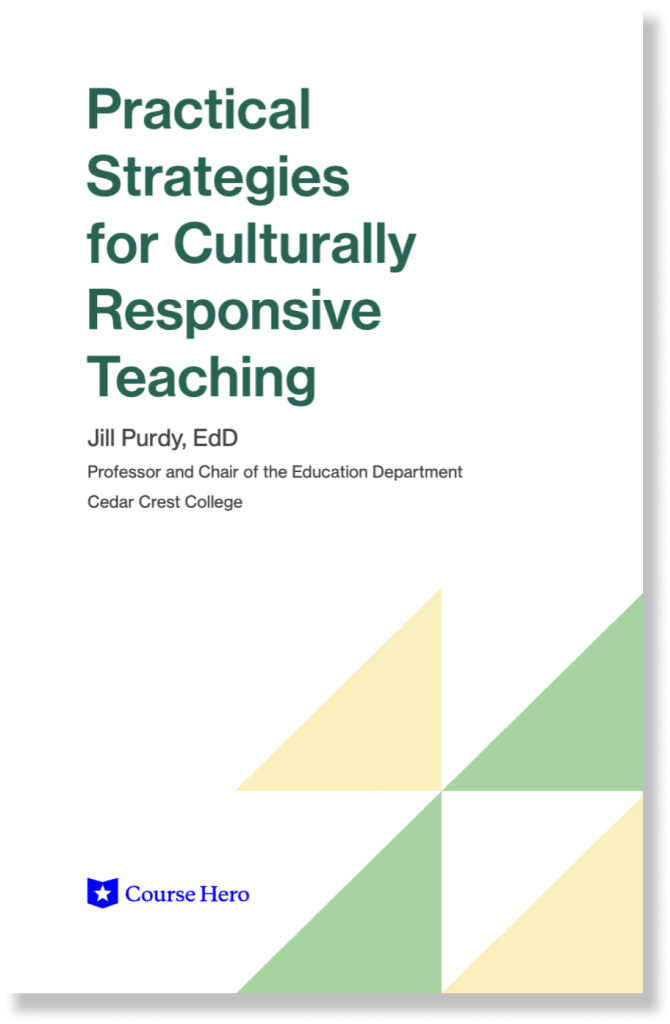
Table of Contents
As a teacher educator, I see the changing dynamics of our classrooms and the challenges of meeting the needs of all our students daily.
I teach at a small liberal arts college with a diverse population. Our faculty has embraced diversity and equity by accepting the challenge of culturally responsive teaching (CRT) with intention.
I want to share some of our successes in the hopes that you can use them to shape your own CRT.
From a practical perspective, I will introduce, reinforce, and supplement your skills with ideas to implement into your course and instruction.
Jill Purdy, EdD, Professor and Chair of the Education Department, Cedar Crest College
I will also discuss several essential components of CRT, such as funds of knowledge and Universal Design for Learning.
Many instructors indicate that they are culturally responsive. Still, we found on our campus that these moments were actually occurring less than we thought—largely due to a lack of intention.
Intentionality begins with honoring the students’ lived experience and the integration of this experience into your teaching environment. As we look further into the course design, we will discuss CRT strategies within the syllabus, course content, and evaluation/assessment.
Learning Objectives
🔎 Educators will examine their understanding and use of Culturally Responsive Teaching strategies.
🌎 Educators will be able to incorporate the students’ lived experiences into their instruction and learning activities.
🧑🏫 Educators will feel prepared to integrate elements of Universal Design into their course design, instruction, and assessment.
Leveraging Student Knowledge
The most important area of Universal Design, in my opinion, is setting up the learning situation.
By that, I mean assessing and activating the students’ prior knowledge. I do this by preparing the learning for the day’s topic. I can do this with a short video, an anecdote, or an activity.
For example, I may have students complete a quick writing exercise about what they know about the topic or jot down a few questions they have. This gets the brain engaged and ready to receive more information.
Remember to:
1. Utilize students’ prior knowledge to enhance their engagement.
2. Integrate ideas shared from Universal Design to create more equitable opportunities for students.
📝 Writing Prompt Ideas
- What is your favorite food tradition?
- Who is your hero/shero?
- Interview a family member about their heritage.
Jot down your ideas for 3 low-lift activities your students can complete during your first week of class.
Creating an Anticipation Guide
The purpose of an anticipation guide is to activate students’ prior knowledge. After the activity, students and instructors can use this guide to check on learning.
Some instructors use this for controversial topics to spur discussion; others use the anticipation guide to gauge students’ knowledge of facts.
Example:
| Agree | Statement | Disagree |
| The fact that teaching Social Studies in elementary school is no longer a key focus inhibits students’ growth in citizenship. | ||
| Students must master phonics prior to successful reading achievement. | ||
| Behaviorists utilize rewards and punishments to manage behavior. This is the best philosophy to adopt as a new teacher. | ||
| The following is a well-written learning objective: Students will be able to understand the concept of photosynthesis. | ||
| Culturally responsive teaching should be part of every teacher education program. |
Try SPUNKI
*Recommended by Harriette Richard, PhD, Associate Professor of Psychology
After a reading exercise, try using the SPUNKI method to engage your students.
Have them share what they found:
- Surprising
- Puzzling
- Unique
- New
- Knew already
- Interesting
Tip:
For those teaching asynchronously, consider including SPUNKI as a regular task on your Learning Management System with a completion-based grade.
Use students’ responses to kick-start class discussions or prompt them to think deeper about their readings.
I like to do the minute paper before a chapter for students to brainstorm everything they know before we talk about the content, and then have them do it again after the chapter on the same paper. It is a great visual of their growth of knowledge.
Dana Kobold, Professor
Steps for Approaching Culturally Responsive Teaching
1. Reflect on your current knowledge of CRT, personal bias, and mode of instruction.
2. Reflect on the current status of the syllabus and content with the goal of intentionally integrating CRT strategies.
❓When looking at your syllabus, ask yourself:
- Do I use inclusive and welcoming language in my syllabus? (e.g., we, our)
- Do I provide student choice in demonstrating learning?
- Do I direct students to support opportunities? (e.g., office hours, online chats, campus services)
Our department diversity statement goes beyond the institution statement. This helps the student specifically see our commitment within the department.
Education Department Diversity Statement
The Education Department believes that at the very heart of teaching is the acceptance of all individuals. Instructional pedagogy and choices are grounded in the values of diversity, equity, and inclusion. The practice of teaching honors students’ voices, encourages thoughtful discourse, and promotes inclusivity.
3. Define Culturally Responsive Teaching and Key Elements.
I define CRT by getting to know my students as individuals. This helps me design instruction based on the particular students in my class and not just the delivery of content. It can be tempting to deliver content the same way regardless of the students in the class—but I try to consider each student when planning a lesson. This takes time for sure and that is the challenge.
4. Examine your syllabus for CRT language and invite the students in as part of the learning community.
Culturally responsive language involves the class as an integral part of instruction. Simple questions can be: What do you think? What is your opinion? How do we come to an agreement on this issue? As the discussion continues, the key idea is for students to form relationships with you and each other by seeing/hearing others’ perspectives and honoring that.
5. Use activities shared to determine students’ prior knowledge with the intention of adapting instruction as needed.
6. Select two strategies to increase student engagement in your course content.
📚 My two go-to activities for engagement are:
- Using the “turn and talk” method for students so they can reflect and engage after a lecture.
- Having students bring 3–5 Post-it notes with questions or thoughts on pre-reading assignments
7. Select something in your course where you can provide student autonomy in how they learn the content or how they show their learning.
My student-athletes think they’re “dumb” and I’m “smart.” I love making them challenge that paradigm and realize that for as “smart” as I am, I cannot even begin to try to do what they do at practice and on the field. They realize there are different ways people can be smart, and each way is uniquely valuable.
Anonymous
Examples of Student Choice in Assessment
These are real examples I use when providing assessment options for students. Giving students more autonomy in the problems they solve empowers them to feel more independent and take ownership of their learning.
Choice 1 Example:
Using Chapter 9 from the text, pp. 239- 244, create your own vision of becoming a collaborative agent for a middle or high school. (Your choice.)
This should include your focus for the literacy program, the collaborative team, what type of professional development will be provided, etc. Use a few of the 9 concepts presented to explain how you will be a collaborative agent for literacy.
How you’ll be scored:
1. Collaborative change model is explained and the student makes it their own. (9 pts.)
2. The student is guided by the readings of the chapter and demonstrates understanding (9 pts.)
3. The essay is free of errors and follows APA when applicable (2 pts.)
Choice 2 Example:
Select one of the reports you read for this module to analyze a bit more deeply. Reread the key points of each report and select two points that are new to your thinking or you feel is essential to adolescent literacy instruction.
With additional research on your own (using a minimum two outside resources), provide a brief explanation of why you chose this element or concept and support it through the additional references.
How you’ll be scored:
1. Selected items are supported in additional resources (9 pts)
2. The student is guided by the readings of the chapter and demonstrates understanding (9 pts.)
3. The essay is free of errors and follows APA when applicable (2 pts.)
Stop and analyze the core sections of your syllabus. Where could you include CRT language?
📊 Tracking Success
1. What is the level of your students’ engagement compared to previous courses you have taught?
2. Are students more connected to the content?
3. Has group work success increased?
Analyze a low-stakes assessment you use to evaluate your students’ learning. How can this evaluation be better aligned with CRT?
I was an international undergraduate student in the US. Something that was really helpful was when my professors would tell us to feel comfortable asking them questions regarding the meaning of the words, even in the middle of a test.
João Vieira, Professor
Final Reflections
Change doesn’t happen overnight. Incorporating CRT strategies can present many challenges in certain classrooms.
However, I recommend focusing on a few ideas to work on each semester. Examine your syllabus language and integrate some activities to assess and activate prior knowledge.
Or incorporate a collaboration technique such as “turn and talk” and provide one student choice. Whatever you choose to incorporate from your learning, do it with intentionality!
Download the Ebook

What’s Inside:
- Steps for approaching culturally responsive teaching (CRT)
- Examples of providing student choice in assessment
- Integrating elements of Universal Design into your course design
Additional Resources
- Building an Inclusive Syllabus
- Making Connections: Intentional Teaching for Integrative Learning
- Activating Prior Knowledge
- Scaffolding Content
- Universal Design in Higher Education: Promising Practices
- Intentional Teaching
- 5 Culturally Responsive Teaching Strategies
- Universal Design: Instructional Strategies
- Anticipation Guides






